On November 19, DESI released another set of papers based on year one (Y1) data. The first set of papers, summarized here, was released on April 4 and focused on a particular feature seen in the clustering of tracers called the Baryon Acoustic Oscillation (BAO) standard ruler. These new results provide an extended, “full-shape” analysis of the Y1 data by looking at how galaxies and quasars cluster on different scales, both in the plane of the sky and along the line of sight in redshift space. This page contains a guide to the publications and main results. The papers are available here and on arXiv.
This visualization was made from simulated DESI data and displays the shift in galaxy positions between real and redshift space. Because galaxy distances are inferred from their recessional velocities, galaxy motions result in shifted positions along the line of sight (LOS) in a redshift map. On smaller scales, galaxy positions are “smeared” along the LOS as they rotate within clusters. On larger scales, galaxies fall into dense regions and their positions become “squashed” along the LOS. The latter of these is the type of redshift-space distortion (RSD) that contains information about the growth rate of structure. The simulated box is 500 Mpc/h across, 300 Mpc/h deep, and points are colored by depth. Credit: Claire Lamman and Michael Rashkovetskyi / DESI collaboration
Helpful links
- A press release containing a high-level overview of our main results: https://newscenter.lbl.gov/2024/11/19/new-desi-results-weigh-in-on-gravity/
- A short video on our results: https://www.youtube.com/watch?v=cVkUumMP6CI
- A list of current papers: https://data.desi.lbl.gov/doc/papers/
- For more background on DESI’s science, see our public webpages.
- DESI’s Y1 data is not yet public, but you can find our early data release and any updates on this site: https://data.desi.lbl.gov/doc/releases/
The Y1 results fall into seven main categories. The three highlighted in blue, based on BAO measurements of galaxies and quasars (DESI 2024 III), BAO with the Lyman-alpha forest (DESI 2024 IV), and cosmological inference from these BAO measurements (DESI 2024 VI), were released on April 4. The three highlighted in pink are released on November 19; the construction of galaxy and quasar catalogs for cosmological analyses (DESI 2024 II), full-shape clustering measurements from galaxies and quasars (DESI 2024 V), and cosmological constraints from this full-shape modeling (DESI 2024 VII). This figure shows the publication organization, where each category corresponds to a key collaboration paper with several supporting papers. Summaries for the key papers highlighted in pink, as well as supporting papers, are listed below.
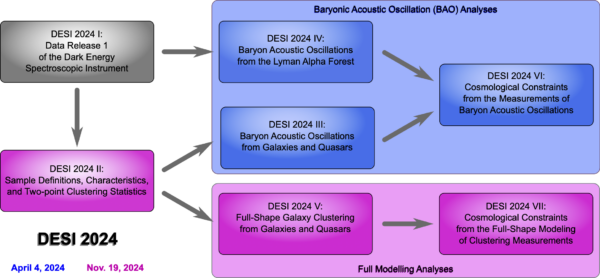
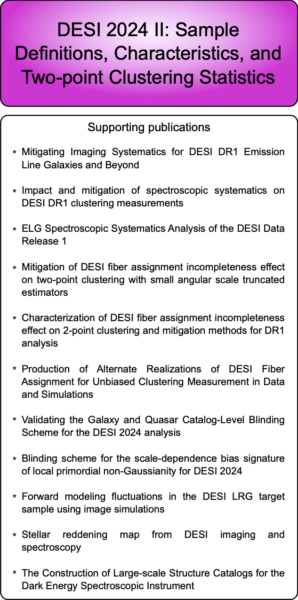
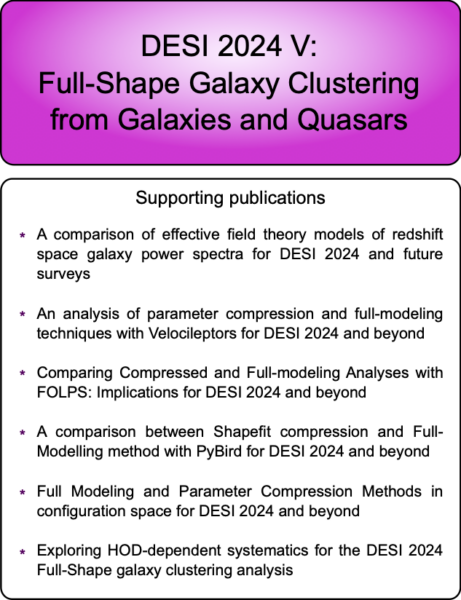
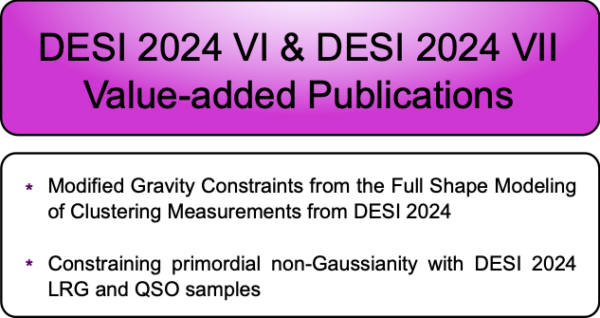
November 19 Paper Summaries
Construction of Galaxy and Quasar Catalogs
Creating galaxy and quasar catalogs is essential for DESI’s cosmological analyses. These papers describe how these catalogs were constructed from the forthcoming DESI Data Release 1 (DR1), and include studies of the effects of systematics and incompleteness on the clustering measurements.
DESI 2024 II: Sample Definitions, Characteristics, and Two-Point Clustering Statistics
arXiv: 2411.12020
Summary: This paper presents the details of the DESI ‘large-scale structure (LSS) catalogs’ constructed using data from DESI DR1. It further presents the details of how 2-point clustering measurements and their covariance are calculated using the LSS catalogs.
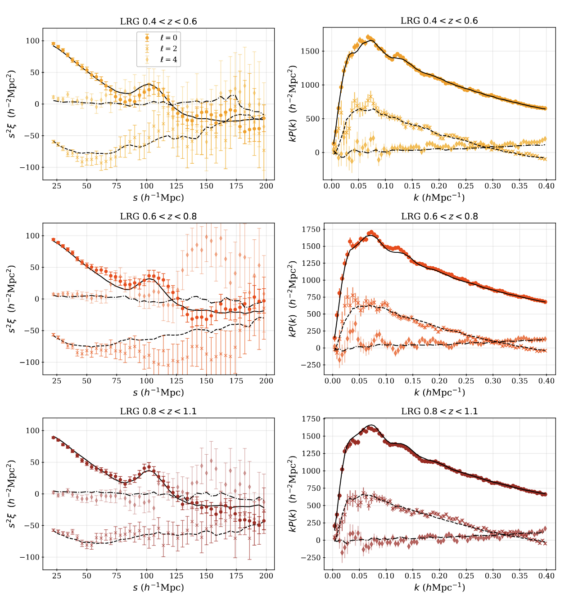
Characterization of DESI fiber assignment incompleteness effect on 2-point clustering and mitigation methods for DR1 analysis
Corresponding author: Davide Bianchi
arXiv: 2411.12025
Summary: The fiber assignment incompleteness, arising from the limited mobility of the robotic fiber positioner in the DESI focal plane, leads to a scale-dependent suppression of the observed galaxy clustering amplitude. If left uncorrected, this effect can significantly affect the inference of cosmological parameters. In this work, we summarize the methods used to simulate fiber assignment on both mock galaxy catalogs and real data, and we discuss the mitigation strategies we implemented to address this issue. We conclude that we can robustly correct for the fiber incompleteness in DESI DR1, as demonstrated in Figures 11 and 12.
Mitigating Imaging Systematics for DESI 2024 Emission Line Galaxies and Beyond
Corresponding author: Alberto Rosado-Marín
arXiv: 2411.12024
Summary: This paper details the angular systematic treatment used for the DESI DR1 emission-line galaxies (ELGs). Separately, we introduce a new methodology for systematic treatment by combining forward-modeling and regression. Furthermore, we present the impact of imaging systematics on the 2-point clustering measurements of BGS, ELGs, LRGs, and QSOs. We also assess the impact of imaging systematics on the BAO measurement.
Full-Shape Analysis from Galaxies and Quasars
The DESI key papers released in April focused on extracting information from the BAO scale. This new set of papers extends this analysis to extract cosmological information from the full shape of the 2-point clustering statistics, allowing for tighter constraints on cosmological parameters. This is the largest dataset ever used to perform a full-shape analysis, with over 4.7 million galaxy and quasar redshifts spanning 0.1 < z < 2.1. The combined precision on the amplitude of the redshift space distortion (RSD) signal, which probes the growth of structure, is 4.7%. Remarkably, this level of precision from just one year of DESI data is comparable to that of 20 years of data from the Sloan Digital Sky Survey (SDSS).
DESI 2024 V: Full-Shape Galaxy Clustering from Galaxies and Quasars
arXiv: 2411.12021
Summary: For the first time, we have performed a “full-shape” analysis of the galaxy 2-point statistics that extracts information beyond the cosmic ruler, the Baryonic Acoustic Oscillations (BAO), and probes the formation of large-scale structures under gravity. We use a sample of galaxies and quasars collected during the first year of DESI. Our galaxy full-shape analysis is in agreement with BAO for the background evolution and confirms the validity of general relativity as our theory of gravity at cosmological scales.
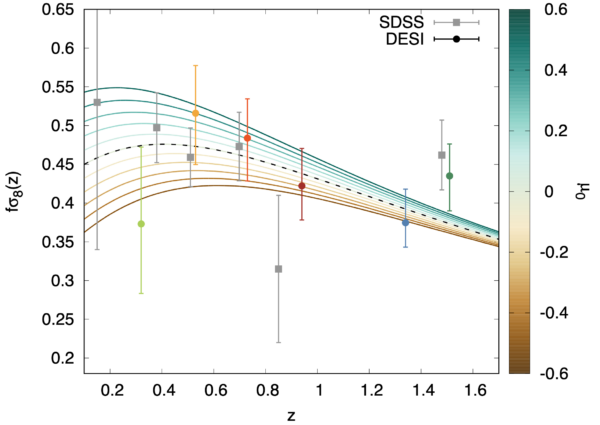
Exploring HOD-dependent systematics for the DESI 2024 Full-Shape galaxy clustering analysis
Corresponding author: Nathan Findlay
arXiv: 2411.12023
Summary: We explore how changing the model of how galaxies form affects the cosmology we infer. We find this to have a very minor effect (Figure 6) and include it as an extra uncertainty in our analysis following a new, more generally applicable approach.
Cosmological Inference
This set of papers provides a cosmological interpretation of the full-shape (FS) analysis described above, combined with the previous BAO analysis. These FS+BAO results constrain the density of matter, Ωm, the amplitude of mass fluctuations, σ8, and the Hubble constant, H0, for a flat ΛCDM cosmological model. Additionally, combinations of DESI (FS+BAO) with CMB and Type 1a supernovae continue to favor an evolving dark energy component. The DESI (FS+BAO) data is also used to test for deviations from general relativity, and results show agreement with it.
DESI 2024 VII: Cosmological Constraints from the Full-Shape Modeling of Clustering Measurements
arXiv: 2411.12022
Summary: Analysis of the first year of DESI data, in combination with other probes, shows preference for a cosmological model where the dark energy density evolves in time. This corresponds to the preference of the parameter w0 in the accompanying plot being different from -1, and wa different from 0. This result persists when we go beyond our earlier analysis of baryon acoustic oscillations signature in the clustering of galaxies, quasars, and features in quasar spectra, and extend it to utilize the full clustering signal of these cosmological tracers. When combined with Planck18 data, our data also tightly constrains the sum of the neutrino masses, which has to be below 0.071 eV.

Modified Gravity Constraints from the Full Shape Modeling of Clustering Measurements from DESI 2024
Corresponding author: Mustapha Ishak
arXiv: 2411.12026
Summary: We have analyzed the data from the first year of DESI allowing for different deviations from general relativity. This analysis combines DESI with CMB data and DES Y3 and is performed at different cosmic times and scales using various methods. We conclude that current data is consistent with general relativity (e.g. μ0 and Σ0 are consistent with 0 in the plot below) and that it still favors an evolving dark energy (wa not 0 and w0 not -1 in the plot below).

BAO Measurements from Galaxies and Quasars
In addition to the papers above, an additional supporting paper for the key paper DESI 2024 III: Baryon Acoustic Oscillations from Galaxies and Quasars, released in April, is now available.
Analytical and EZmock covariance validation for the DESI 2024 results
Corresponding author: Daniel Felipe Forero Sánchez
arXiv: 2411.12027
Summary: In cosmology, estimating uncertainties in large-scale structure analyses is crucial. Two methods are used: analytical covariance, which is fast and flexible but limited in handling complex systematics, and sample covariance, which is more accurate but resource-intensive. For the completed DESI 2024 analyses, analytical covariance is chosen for Baryon Acoustic Oscillations (BAO), while corrected sample covariance is used for Full-Shape analysis due to better accuracy in Fourier space.